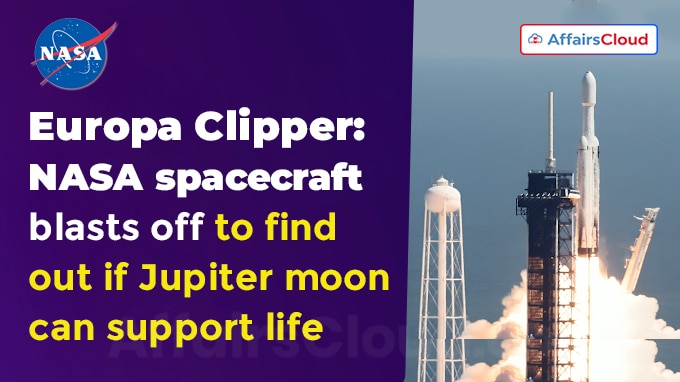 On 14th October 2024, the National Aeronautics and Space Administration (NASA) launched its Europa Clipper spacecraft under the Europa mission to study Jupiter and its moon Europa, one of Jupiter’s 95 known moons.
On 14th October 2024, the National Aeronautics and Space Administration (NASA) launched its Europa Clipper spacecraft under the Europa mission to study Jupiter and its moon Europa, one of Jupiter’s 95 known moons.
- The spacecraft aboard a Space Exploration Technologies Corporation (SpaceX)’s Falcon Heavy rocket and was lifted off from Launch Complex 39A at NASA’s Kennedy Space Center, Florida, the United States of America (USA).
- This marks NASA’s 1st mission dedicated to studying an ocean world beyond Earth.
- The primary objective of the mission is to determine whether icy shell of Europa and its ocean underneath could support life.
Europa Mission:
i.NASA’s Europa mission is part of its Artemis program, which aims to send astronauts back to the Moon and eventually to Mars. The cost of the mission is USD 5.2 billion.
ii.It is being managed by Jet Propulsion Laboratory (JPL), managed by Caltech in partnership with Johns Hopkins Applied Physics Laboratory (APL).
Time line of the Mission:
i.The Europa Clipper spacecraft will cover the distance of 1.8 billion miles (2.9 billion kilometer (km)) and will enter into Jupiter’s orbit by April 2030 and will begin its scientific operations in 2031.
- The mission will conclude in 2034 with a planned crash into Ganymede, largest moon of Jupiter.
ii.During the mission, the spacecraft will make nearly 50 flybys of Europa at closest –approach altitudes as low as 16 miles (25 kms) above the surface.
About Europa Clipper Spacecraft:
i.Europa Clipper is the largest spacecraft ever built by NASA for a planetary mission, mainly due to its massive solar arrays.
ii.The main function of these large solar arrays is to collect enough light to meet its power requirements as it operates in the Jupiter system, which is more than 5 times as far from the Sun as Earth.
iii.The spacecraft includes 9 instruments such as: sensitive electronics stored in a vault with dense zinc (Zn) and aluminum (Al) walls will protect the spacecraft against radiation.
iv.The payload of spacecraft will include cameras and spectrometers to produce high-resolution images and composition maps of the surface of Europa and thin atmosphere, an ice –penetrating radar to search for subsurface water.
- Also, the magnetometer and gravity measurements will used to explore its ocean and deep interior.
- Thermal instrument will be used to map temperature variations across Europa’s surface.
- While, other instruments of the spacecraft will be used to examine surface composition for potential salts and organic molecules.
Points to Note: Other missions for Jupiter planet: Juno mission of NASA, has been orbiting Jupiter since 2016; and the European Space Agency (ESA)’s Jupiter Icy Moons Explorer (JUICE), launched in April, 2023.
Recent Related News:
The European Space Agency (ESA) has announced to launch its new mission named Rapid Apophis Mission for Space Safety (Ramses), by early 2028 to study the asteroid Apophis as this asteroid is expected to pass Earth on 13th April, 2029.
About National Aeronautics and Space Administration (NASA):
Administrator– Bill Nelson
Headquarters– Washington DC, the United States of America (USA)
Established– 1958


